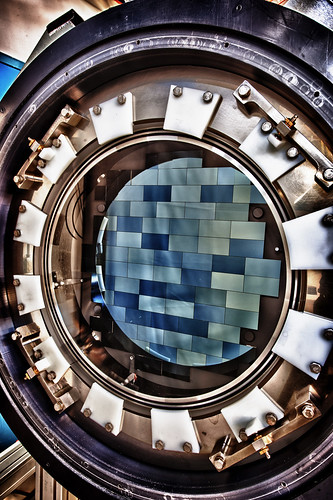Dark Energy Camera

|
| The 570-megapixel CCD array of the DECam. In use, this sits behind large corrector lenses and the interchangeable filter mechanism image by Fermilab (Image rights) |
The Dark Energy Camera or DECam created at Fermilab became the biggest digital camera in the world when it entered service in 2012[1] at the 4 -meter Blanco telescope of the Cerro Tololo Inter-American Observatory in Chile.
The camera was designed as the research instrument for the Dark Energy Survey, which uses repeated wide-field astronomical observations to shed light on fundamental questions in cosmology.
As this camera was designed for observations of highly-redshifted light, it uses special CCD chips, developed by the Lawrence Berkeley National Laboratory and manufactured by Dalsa. These have a large 15µm-square pixel size, and an extra-deep silicon substrate to maximize photon-capture efficiency at far-red wavelengths.
The primary imaging area is a mosaic of 62 CCDs, each of 2048 x 4096 pixels, for 520 megapixels in total. At the edges of the focal plane, twelve additional CCDs of 2048 pixels square are dedicated to focus calibration and guide-star tracking. These extra 50 pixels are included in the description of the DECam as a "570 megapixel camera" (as typically quoted in publicity materials). The CCD array is cooled to -100°C to reduce thermal noise, held within a vacuum chamber to prevent condensation from forming. Each exposure results in a file size of around a gigabyte, and takes 17 seconds to read out from the sensor[2].
Starlight reflected off the 4-meter-diameter mirror surface passes through corrector optics consisting of five lenses; the largest of these is almost a meter in diameter and weighs 173 kg (380 lbs)[2]. Combined, the whole optical system has an effective focal length of about 11,600 mm and works at f/2.9. With the corrector-optics assembly and filter changer, the camera's complete weight is 4 or 5 tons[3]. The complete camera is somewhat larger than a telephone booth[4].
After checkout and calibration was completed, the Dark Energy Survey observation campaign officially began on August 31, 2013[5]. The complete survey will take five years to complete.
The title of "world's largest digital camera" may eventually pass to the LSST Camera, a somewhat similar design with a planned 3,200 megapixel resolution.
Notes
- ↑ "World’s most powerful digital camera opens eye, records first images in hunt for dark energy" from Fermilab, the Fermi National Accelerator Laboratory.
- ↑ 2.0 2.1 "Additional Information about DECam" from The Dark Energy Survey
- ↑ "New Camera Sheds Light on Dark Energy" from the US Department of Energy
- ↑ A photo of the camera and two technicians illustrates its size.
- ↑ "Dark Energy Survey begins five-year mission to map southern sky in tremendous detail" from Fermilab